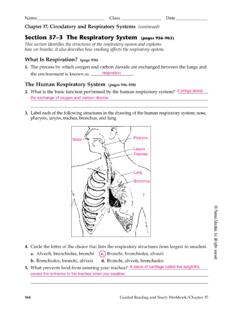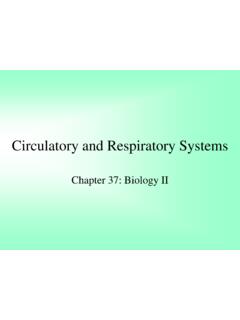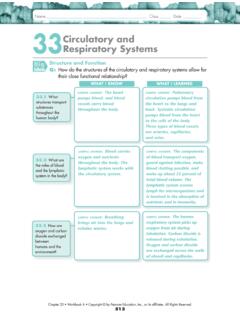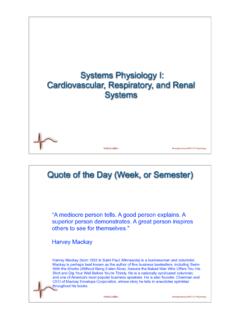Transcription of CARDIOVASCULAR AND RESPIRATORY SYSTEMS
1 Warner Pacific College BIO 102 circulatory & RESPIRATORY SYSTEMS 1 NAME: _____ DATE: _____ PARTNER: _____ CARDIOVASCULAR AND RESPIRATORY SYSTEMS The CARDIOVASCULAR and RESPIRATORY SYSTEMS of animals are intricately associated to allow the delivery of oxygen (O2) to and the removal of carbon dioxide (CO2) from the cells of the body. In this laboratory, you will examine some of the major structures of these SYSTEMS , the heart and lungs in particular, to learn more about their individual and joint functionality. I. THE VERTEBRATE CARDIOVASCULAR system A.
2 The Mammalian Heart 1. Use the diagram in your text to familiarize yourself with the structures of the heart and identify those listed below. A. aorta B. aortic semilunar valve C. chordae tendinae D. inferior vena cava E. left atrioventricular valve (bicuspid) F. left atrium G. left ventricle H. pulmonary artery (pulmonary trunk) I. pulmonary semilunar valve J. pulmonary veins K. right atrioventricular valve (tricuspid) L. right atrium M. right ventricle N. superior vena cava O. septum Warner Pacific College BIO 102 circulatory & RESPIRATORY SYSTEMS 2 2.
3 Obtain a preserved heart and use the previous and following diagrams to identify the structures listed below (check them off the list as you locate them). ___ aorta ___ aortic semilunar valve ___ chordae tendinae ___ coronary artery ___ inferior vena cava ___ left atrioventricular valve (bicuspid) ___ left atrium ___ left ventricle ___ papillary muscle ___ pulmonary artery (pulmonary trunk) ___ pulmonary semilunar valve ___ pulmonary veins ___ right atrioventricular valve (tricuspid) ___ right atrium ___ right ventricle ___ superior vena cava ___ septum a.
4 What is the function of the heart valves? _____ _____ _____ b. What is the function of the chordae tendinae? _____ _____ _____ c. You may notice that the left ventricle wall is thicker than the right ventricle wall. How might this be functionally significant? _____ _____ _____ _____ Warner Pacific College BIO 102 circulatory & RESPIRATORY SYSTEMS 3 3. Using colored pens/pencils/crayons, draw arrows in the diagram from question 1 to indicate the direction of blood flow through the heart and associated vessels. Use one color (preferably red) to represent "oxygenated" blood and another (preferably blue) to represent "deoxygenated" blood (if you use other colors, be sure to indicate which color represents which degree of oxygenation).
5 A. What are the pulmonary and systemic circuits? _____ _____ _____ _____ b. From where do the muscular walls of the heart receive their blood supply? _____ _____ _____ B. Vertebrate Circulation 1. Note the following diagrams of fish, amphibian/reptile and mammal/bird circulatory patterns. a. Identify one significant structural difference between the amphibian/reptile and mammal/bird SYSTEMS . _____ _____ _____ b. Identify one significant difference between the circulation pattern of fish and the other animal SYSTEMS . _____ _____ _____ a) Fishes b) Amphibians & Reptiles c) Mammals & Birds Warner Pacific College BIO 102 circulatory & RESPIRATORY SYSTEMS 4 II.
6 THE VERTEBRATE RESPIRATORY system A. Mammalian Lungs 1. Use your text to help identify the structures in the following diagrams. Write the terms in the diagram using the list below. 1. alveolus 2. bronchus 3. bronchiole 4. diaphragm 5. epiglottis 6. larynx 7. lung 8. nasal cavity 9. pharynx 10. trachea 2. Now examine the sheep pluck on display (this consists of the heart, lungs and major vessels of these organs). a. Identify the trachea. What is the purpose of the rings of cartilage that surround the trachea and bronchi? _____ _____ _____ b.
7 How many lobes are present in the right lung of a human? ___ The left lung? ___. What functional purpose is served by the two lungs not being identical in size? _____ _____ _____ _____ Warner Pacific College BIO 102 circulatory & RESPIRATORY SYSTEMS 5 B. Lung Capacity In this exercise, we will use a spirometer with a computer interface to measure selected air capacities of your lungs. Follow the procedure handout supplied with the spirometer (demonstrated by instructor). 1. Set up the spirometer (steps 1-3). 2. Inhale and exhale a few times as you would in a normal breath then begin breathing into the spirometer per instructions (steps 4-5).
8 3. Determine your Tidal Volume (TV) in liters (L): the volume of air inspired in a normal breath (step 6). a. TV = _____ L 4. Determine your Vital Capacity (VC): the total volume of air that can be expired after maximum inspiration. This is done by determining the volume between the peak of the maximum inspiration and the valley of the maximum expiration. a. VC = _____ L 5. Print a copy of your data to turn in with the lab (per instructor s directions). 6. Use the meter sticks provided to measure your height in meters (m): _____. 7. Enter your Vital Capacity (L) and your height (m) into the table on the board and record the total class results in the following table: Sex Ht (m) VC (L) Sex Ht (m) VC (L) Sex Ht (m) VC (L) 8.
9 Construct a scatter plot figure (including trendline) using Excel showing height in meters (x-axis) vs. vital capacity in liters (y-axis). Be sure to follow proper figure format (handout from lab #1). Print a copy to turn in with the lab; attach to the end after your own data printout from step 5. a. What generalizations can be made regarding height and vital capacity of the class? _____ _____ Is there a difference between males and females? ____ If so, how might you account for this? _____ _____ _____ Warner Pacific College BIO 102 circulatory & RESPIRATORY SYSTEMS 6 III.
10 RELATIONSHIP BETWEEN CARDIOVASCULAR AND RESPIRATORY SYSTEMS Work in pairs and perform the following tests on your partner. However, be sure to record your own results on your data sheet. The test subject should try to remain as still and calm as possible during the test procedures. A. Blood Pressure 1. Before starting the exercises that follow, view the computer video clip about blood pressure ( blood_pressure). a. What happens when the cuff of the sphygmomanometer (blood pressure measurement device) is inflated? _____ _____ b. What is being measured when the first sounds are heard through the stethoscope?










